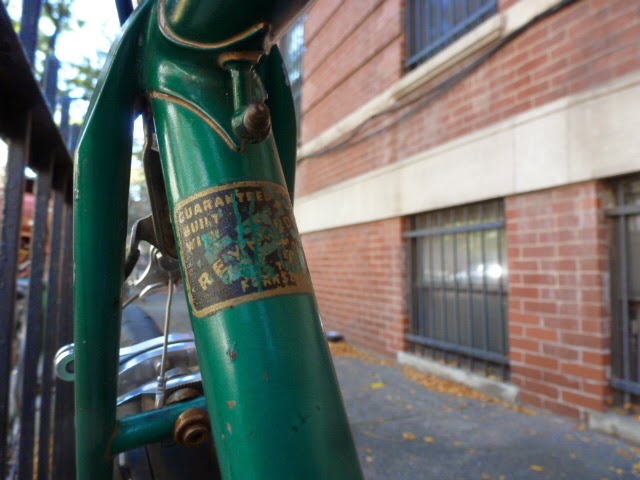Vera doesn't seem to have suffered any structural damage from the accident a few weeks ago. I feel confident in saying that after doing some work on it.
In the course of doing some maintenance and repair, I decided to make a few changes. One involved going to a slightly longer handlebar stem extension. I took the opportunity to install one with a built-in cable hanger:
And, as you will notice, I did something to the stem. Look at how the bell is attached. Yes, I drilled a hole and tapped it so that the bell, which I unscrewed from its bracket, threaded in.
The bell, by the way, is Japanese. I bought it from Velo Orange. From what I understand, it's also available from Jitensha Studios.
One reason I decided to set up the stem that way was to de-clutter the front. Also, having a cantilever brake means having a hanger, and whoever originally set up this bike didn't leave much room in the steering column for much besides the headset. There was enough room for the hanger, but I wanted to put something else in there:
Yes, I made the plunge: I'm using a decaleur, also from Velo Orange. More to the point, I'm using it on a great piece of kit: RuthWorks' Randonneur bag.
I've written about his Brevet and wedge bags in other posts. Ely Rodriguez makes RuthWorks bags and seems to have a great time doing it. Not only does he offer canvas (and other materials) in all sorts of colors; he pays great attention to detail. So, his bags are full of all sorts of thoughtful features as well as great workmanship.
I love the way the top flap opens. I suspect that it provides greater protection against the elements, though I have not yet ridden with this bag in bad weather.
It's hard to believe that in all of the years I've ridden, I've never before used a front bag like this one, much less a decaleur. It seems that those things disappeared from the face of the Earth right around the time I got involved in cycling. I didn't even see them in Europe: It seems that all of the traditional manufacturers of bicycle luggage and the stuff you need to use them on bikes disappeared, or started to use synthetics where they once used cotton duck canvas and more modern methods of attaching the bags.
And, it seemed that the world was forgetting about how to position bags. (I actually had a Specialites TA front bag that I never used because no one had any idea of where to find the hardware I'd need for it.) One ironic result was that we were always complaining that our handlebar bags bounced: All of the lore and science that would have told us that they were really meant to be front bags, not handlebar bags (which meant they'd mount lower on the bike , close to the wheel rather than high up on the handlebar) disappeared like the scrolls and books that burned in the Library of Alexandria.
What this means is that I wish I'd known about bags like this, and how to use them, when I took my European, New England and California-Nevada tours. I would have been so much more comfortable about carrying the Honeywell Pentax I brought on those trips! And, let's face it, with a bag like the one Ely made for me, I would have been riding in style.
My bag includes large velcro strips that wrap around the rails of a front rack. It might be possible to use the bag with just those straps and no decaleur. (Perhaps the bag could also be lashed to the rack's "tombstone".) It's also possible to use it with something like the Nitto F15 handlebar support or the Rixen Kaul "Klick Fix" system. Either of those supports, however, attach to the handlebars themselves and render the bag more like a traditional handlebar bag.
If you order one of these bags, you can ask Ely to make it without the loops for the handlebar rack or the Velcro straps. You can also ask him to make other accommodations for whatever racks and attachment systems you use. He's very willing to work with you on helping you get a bag you like. He even makes "vegan" bags, without leather or other animal products.
Now, I grant that this is my first experience of using such a piece of bike luggage. So I can't honestly compare it to other boxy Randonneur bags. However, I can wholeheartedly recommend this piece of kit for its details, convenience features and Ely's workmanship.
And, oh, can you tell that I love the color? It's called Nantucket Red, but it's really more like a salmon pink. My other RuthWorks bags in that color are great on my other Mercians, with the purple/green "flip=flop" (#57) finish. I was tempted to ask him to make a gray or black bag for Vera, but I think I like this color with the British Racing Green finish. What do you think?
(You've noticed another bag on the rear of Vera. I'll write about it soon.)
















